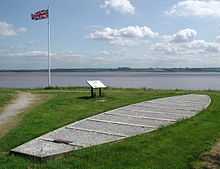Ferriby Boats

The Ferriby Boats are three Bronze Age Britain sewn plank-built boats, parts of which were discovered at North Ferriby in the East Riding of the English county of Yorkshire. Only a small number of boats of a similar period have been found in Britain and the Ferriby examples are the earliest known sewn-plank boats found in Europe, although the Hanson Log Boat is of similar age.
Oldest Sea-going Boat?
Ferriby is on the edge of a major estuary, the Humber, so speculation has been made ever since their discovery about whether they went to sea and sailed to the Continent. There is plenty of evidence that there was cross-channel communication,[1] but it is not known what kind of boats actually sailed across. Keith Miller, a regional achaeologist told the BBC that Ferriby boats would have been used to cross the North Sea[2] and certainly the Ferriby Heritage Trust describe Ferriby Boat 3 as Europe's first known seacraft.[3] The BBC television programme Operation Stonehenge: What Lies Beneath Pt 2, broadcast on BBC Two in September 2014, describes the boat as seagoing and describes the tons of cargo it could have taken across the Channel. However, The Dover Museum consider that the Dover Bronze Age Boat is the oldest seagoing boat known, at only 1550 BC.[4] They are backed by the Time Team Special, broadcast in September 2014 on UK Channel 4, which stated that to be a proper sea-going, cross-channel vessel the boat would have to have the curved 'rocker' bottom and the (unproven) pointed bow that only the more modern Dover boat possesses.
Ferriby Boat 1
In 1937, the first boat, known as Ferriby Boat 1 (or F1), was discovered by Ted and Will Wright, on the shore of the Humber.[5] It was a boat bottom with one end almost complete. What remained was 5.7 feet (1.7 m) wide and over 43 feet (13.17 m) long, the planks mostly 3–4 inches thick. It was part of an oaken three-strake flat rockered-bottom boat which had been stitched together with yew withies, caulked with moss and capped with watertight oak laths. It has room for up to eighteen paddles and has been radiocarbon dated to between 1880 and 1680 BC.
Ferriby Boat 2
Sixty yards upstream, Ted Wright found the end of a second boat-plank in 1940.[5] This has become known as Ferriby Boat 2 (or F2). It is a twin-planked centre-strake dated to between 1940 and 1720 BC.
Ferriby Boat 3
In 1963, part of a third boat was discovered, again by Ted Wright, this time in the company of one of his sons, Roderick, and excavated adjoining Ferriby Boat 1. The remains consist of part of an outer bottom-strake and associated side-strake; many years later (in the late 1990s), scientists from Oxford were able to demonstrate that the third boat dated from as far back as 2030 BC, by the analysis of samples of the boat using accelerator mass spectrometry.
Ted Wright had formulated this theory much earlier, as set out in his book "The Ferriby Boats: Seacraft of the Bronze Age", published in 1990.
Display
The original boats were excavated in 1946 and unfortunately had to be cut up to be moved. They now are housed in the Archaeological Gallery of the National Maritime Museum in Greenwich. Details concerning the boats can, however, be found on an information board on Ferriby foreshore, on a public footpath that forms part of the Trans Pennine Trail. The path goes from Ferriby to Hessle alongside the Humber Estuary, and gives probably the best views of the Humber Bridge.
Replicas
Two different replicas have been made of the Ferriby Boats.
Oakleaf
In 2002-2003, Edwin Gifford and his team that included Richard Darrah built and sailed a half-size reconstruction of a Ferriby boat in Southampton.[6] They have experimented with using a sail; although there is no evidence of a sail in the originals, they successfully rigged a square sail to Oakleaf. Oakleaf was then acquired by the Ferriby Heritage Trust in 2008, and it is now kept at Ferriby.
Morgawr
In 2012–13, the Morgawr, a full-scale fully functional reconstruction (replica) of the Ferriby 1 boat, was built at the National Maritime Museum Cornwall in Falmouth, as a collaborative effort between the National Maritime Museum and the University of Exeter. Launched on 6 March 2013, Morgawr is an experimental archaeology endeavour to learn about Bronze Age boatbuilding techniques (replica bronze tools of the Age were used) and to test the nautical capabilities of the craft. Morgawr was successfully launched on 15 March 2013 into Falmouth Harbour and on her maiden voyage was paddled by the volunteer builders. She has also been sailed by a rowing club team, testing her manoeuvrability and speed. In 2014, having been in the water for many months, she has been lifted out to inspect and study her condition.
See also
- Dover Bronze Age Boat- a later, wider boat.
References
- ↑ Ven der Nort, Robert (2004). "An ancient seascape: the social context of seafaring in the early Bronze Age". World Archaeology 35 (3).
- ↑ "Bronze Age boat 'oldest in Europe'". BBC News. Retrieved 18 March 2015.
- ↑ "Welcome and introduction". Ferriby Heritage Trust Ltd. Retrieved 18 September 2014.
- ↑ "Bronze Age Boat The world's oldest known seagoing boat". Dover Museum. Retrieved 18 September 2014.
- ↑ 5.0 5.1 "Plaque of memorial". Geograph. Retrieved 11 August 2011.
- ↑ "The Ferriby Boat". Retrieved 18 September 2014.
- Ferriby Heritage Trust. "ferribyboats.co.uk". Information on the Bronze Age boats found at North Ferriby, East Yorkshire, England, UK. Retrieved 2 January 2007.